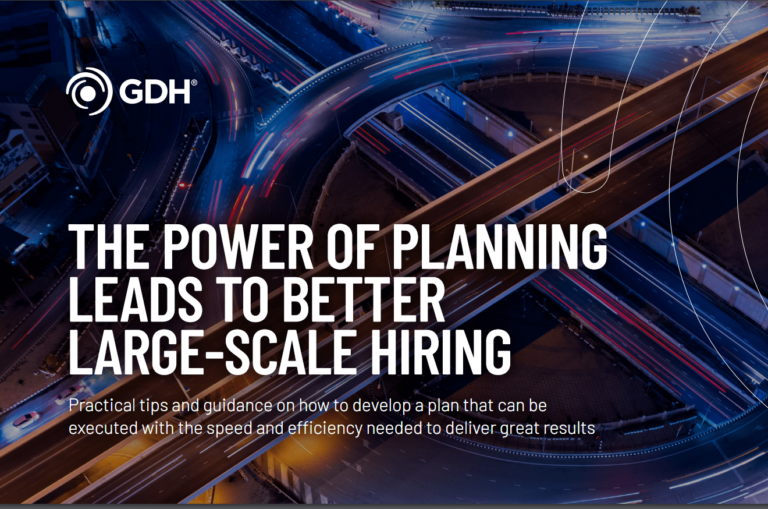Navigating the AI Landscape: Solutions and Strategies for Real Business Challenges – AT&T
Everyone is using AI to solve real business problems, right? You’d seem to think so with all the noise in today’s market around artificial intelligence, security, and efficiency creation. How do you know what’s real? Who can you trust?
Anyone who has experimented with artificial intelligence quickly realizes that using AI immediately creates non-technical challenges. From process redesign to data management and governance in data training, to reskilling or redeploying workers displaced by AI’s capabilities, effective use of AI requires deep and practical expertise.
The below GDH case studies demonstrate how AI’s power creates many unanticipated challenges for firms at the cutting edge, ranging from scalability all the way through workforce reskilling and management. Unlike other firms, GDH provides solutions to the biggest challenges facing retail organizations, pairing our two decades of workforce management experience with advanced technology experts to give you unparalleled results.
GDH supports its clients through multiple Workforce Solution offerings. This includes flexible staff augmentation offerings allowing customers to move quickly and safely through the hiring process of critical, rare, and emerging skill sets. In addition, GDH offers enterprise services solutions that include establishing robust governance frameworks and exceptional service delivery management, GDH PS has the ability and expertise to deliver fully or partially owned outcomes across several core service offerings, including Digital Transformation.
Our engagements within retail, logistics, security and supply chain management have shaped our approach to solving the most complex industry challenges for some of the largest companies on the globe. What can we do for you?

Cybersecurity Threat Detection and Mitigation
Bad actors and opportunists attempted over 934,000 cyber attacks in the US in 2023, resulting in $10.3 BILLION in financial losses and 33 billion account breach events. 24% of these attacks were focused on online retailers, and 99% were financially motivated, targeting payment information and personally identifiable data.
Retailers that aren’t prepared will be attacked, and will lose money, credibility, and brand reputation. But even those that are will find out that they are not prepared for the next generation of cyber threat – AI-enhanced bots.
Current threat vectors for online retailers include credential stuffing, ransomware, and inventory manipulation. One of the most common attack vectors are “grinch bots”, which aim to “scalp” in demand inventory from specific retailers, or specific geographic locations, and “re-platform” that inventory at substantial premiums, essentially hi-jacking a company’s supply chain. While many companies field advanced cyber security teams and intrusion detection measures to identify and neutralize grinch bots, even the most advanced are struggling with machine-learning equipped bots that learn from attack responses to make subsequent attacks or attack actions more effective. Actors employing these “superbots” may use military-like attack sequences that include reconnaissance attacks, feints, and IoT attrition attacks that enable threats to find the vulnerability in a viciously defended corporate perimeter.
“Many financially motivated cyber actors are using sophistication against eCommerce retailers that we’ve only seen in state actors before,” says Thomas Mirc, GDH’s expert in Applied Technology solutions, a former advisor to the US Army War College National Security Summit. “Detection and response paradigms are not enough, companies today need to be thinking about how to apply proactive and aggressive strategies against these actors and tactics.” Thomas has advised several leading retailers on how to rapidly evolve their security frameworks and posture.
Loss Detection and Prevention
The most advanced retailers can detect in-store potential losses in real time through Artificial Intelligence-aided visual algorithmic monitoring and reconciliation systems. Despite this capability, even the most advanced retailers are finding themselves powerless to stop inventory shrinkage. Thomas worked with one of the largest retailers in the United States, to apply advanced security systems, only for the retailer to discover a great irony.
“We can detect, to the second, when an individual has stolen or hidden merchandise with a likely intent to steal. That individual is flagged as they walk around the store,” says the confidential Loss Prevention Manager, who manages operations for over 355 locations. “But, the breakdown happens at the point of sale or point of exit. Because we often don’t have enough physical security to confront the individual, we have to rely on our on-hours manager, or in some cases, our customer service associates.”
Retailers are often left with the solution to the hardest part of their biggest problem – who is stealing what in a store, and when did it happen, but no solution to actually stopping it from happening.
GDH’s Team has advised and worked with a number of retailers on both sides of this problem – a) how to detect potential inventory loss, and b) what to do with this information to prevent inventory shrinkage. From planogram changes to automated IoT security responses, to workforce training, GDH offers a range of solutions to the retail community, helping its customers achieve demonstrable results.

Supply Chain Assurance and Channel Offload
GDH helps companies maintain supply chain assurance. One of the largest names in Consumer foods saw their market share erode rapidly due to supply chain security issues. The firm lost 9% market share over just 180 days, largely due to blind spots and a lack of data reconciliation between inventory and distribution as new enterprise systems came on line. The solution provided helped the organization develop a roadmap that unified supply chain inventory data with the right managers in the organization, enabling faster and better marketing and logistic decisions. Within 90 days, the organization was able to recapture lost shelf space, ironically taking advantage of similar problems at a competitor, because they were ready to ship product with full assurance to high demand locations.
Many firms are attempting to accelerate retail fulfillment to online versus higher cost brick and mortar units – shifting in person sales to the eCommerce channel. Our services helped a luxury retail goods firm use better data architecture and machine learning concepts to assess projected seasonal demand by SKU to create channel promotions. An effort this complicated meant that the partner needed to align executive stakeholders, needed to bring the highest level of data and AI aptitude to the table, and needed to execute flawlessly and with discipline to earn trust. The result? A 19% increase in brick and mortar channel offload over 3 quarters, enough to demonstrate to investors that the firm was truly moving the needle in the right direction once-and-for all.
Healthcare Data Management
While many large employers are entering the healthcare space, not all of these employers are ready for the compliance challenges they face in doing so. HIPAA violations can range from $100 per incident, to $50,000 per incident. Combine tens of millions of customer records stored in enterprise databases with nearly 1 billion attacks per year by cybercriminals, and the changing regulatory landscape in the US, and companies entering the healthcare space face a severe price for shortcomings in healthcare data management.
GDH understands the healthcare data landscape and the steps that firms need to take to demonstrate compliance, prevent cybertheft of PII and HIPAA sensitive data, and create proactive security programs to ensure the safety of client data. From designing data firewalls and structuring business processes to ensure data security and confidentiality, to partitioning data between complicated corporate structures and multiple business entities, GDH has extensive experience in security program design and implementation.
In 2022, GDH’s security experts led an engagement with one of the leading names in critical care simulation to redesign and overhaul its data and infrastructure architecture, enabling the company to achieve the highest level of Federal regulatory compliance in 14 months. This effort involved hybrid, on-prem, and cloud-native hosting environments on 4 continents, WAN and LAN network considerations in field environments, and the added challenge of ensuring high performance for data transmission for over 25,000 IoT end devices in asynchronous and asymmetrical network environments across global network providers. The client’s challenge was security first, and then scaling those higher-level standards across inconsistent global network and cloud environments. We needed to ensure that the data architecture complied with the highest degree of security considerations, without compromising IoT device performance or availability in the field. GDH was able to understand the nuances of the company’s challenge immediately, saving valuable time and cost, and was able to attain credibility and influence collaboratively, enabling the program to move quickly with confidence.

Workforce Management, Reskilling, Replacement, and Cost Management
Large Language Models enable companies to free data trapped in manuals, PDFs, catalogs, databases, and websites to better serve their customers and prospects. Evolving an asset management database into a functioning AI-bot can greatly improve and personalize the client experience, resulting in more brand loyalty and LCV (lifetime customer value). But what happens when companies start applying multiple LLM’s in different parts of the organization, using different AI enablement platforms? “The result is a mess, and companies need to be aware that the powerful solution to today’s problem will become tomorrow’s costly problem, creating more pain than benefit.” That pain often goes well beyond the customer experience.
“When firms use LLMs to enhance the buying experience, they will often realize powerful efficiencies quickly.” One of GDH’s clients used an LLM to solve a million-plus SKU entitlement problem. “When a company has over a million entitlement/SKU permutations, they often have a hundred people involved in SKU administration. Database Admins, Analysts, Data Entry, Scanner technology, those who keep the lights on in IT, sales and product managers, inventory management personnel, you name it.” When an LLM is introduced, it greatly simplifies the operating environment. Rather than requiring a mini-army of personnel to keep order and structure, an LLM can provide order without structure, making operations significantly easier.
When an organization creates efficiency quickly through applied AI, they often face a problem they didn’t think about. “What happens when we have strong, good employees who suddenly don’t have as much (or anything to do)?” Some companies may choose structured personnel reductions, but others may want to avoid either the public stigma of replacing people with AI, or may want to refocus strong and loyal employees on more valuable business challenges.
GDH has engaged on everything from helping companies to decide how to strategically approach workforce reductions, to how to train or re-home employees to other roles within or outside the company, to nearshoring high cost labor to low cost regions while maintaining quality. Some firms have turned to GDH to improve their operating margins and reduce labor costs by 50-60% through nearshoring, while maintaining quality standards. Others have turned to GDH to manage the change associated with the efficiencies created by AI support applications – helping workers find new jobs within the company, or beyond.
With two decades of experience in workforce management, GDH is a powerful ally to firms looking to face the “wake of the AI opportunity” – a very real challenge facing US companies today. In GDH, you find a partner who can help enable the use of transformative AI-driven technology, as well as one that can manage the organizational waves in this wake. No other partner can offer both with the experience and global credibility GDH brings to the table.
“GDH has engaged on everything from helping companies to decide how to strategically approach workforce reductions, to how to train or re-home employees to other roles within or outside the company, to nearshoring high-cost labor to low cost regions while maintaining quality. With two decades of experience in workforce management, GDH is a powerful ally to firms looking to face the “wake of the AI opportunity” – a very real challenge facing US companies today. In GDH, you find a partner who can help enable the use of transformative AI-driven technology, as well as one that can manage the organizational waves in this wake. No other partner can offer both with the experience and global credibility GDH brings to the table.
Ready to navigate the AI landscape with confidence? Contact us today to discover how GDH’s expertise can empower your business with innovative solutions and strategies. Let’s embark on this journey together towards achieving your goals.


